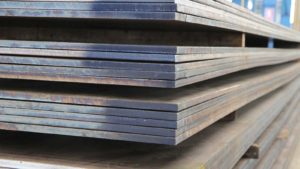Things seemed to be slowing down after interest rates were raised eleven times in the previous 18 months, but according to the most recent data, the inflation rate for the last 12 months as of March is 3.5%, which has many people searching for steel stocks to sell from their portfolio.
The logic is straightforward. Steel stocks are closely linked to the overall economy and are part of a very cyclical sector. Because markets were anticipating at least three rate decreases in 2024, the first quarter was favorable. With January and February 2024 inflation rates of 3.1% and 3.2%, respectively, the most recent inflation data contrasts poorly, which changes the mood and warns of peril for steel businesses with heavy debt loads and premium values.
ArcelorMittal (MT)

ArcelorMittal (NYSE:MT) enjoys the benefits of scale and a global footprint, but a heavy debt load lands it on this list of steel stocks to sell.
Economic downturns or global steel demand drops might disproportionately affect such enterprises, particularly if loan rates remain high and show little indication of change.
In December 2021, the global steel corporation spent $357 million in interest charges and, recently, $715 million. Additionally, U.S. metal sheet costs are falling. For February 28, spot pricing was roughly $800/ton. When interest rates are rising, dropping steel prices is bad news for the corporation.
Yet another reason to avoid buying the stock now is its recent surge. Steel firm shares rose 12% in six months. ArcelorMittal’s P/E ratio is 25.11x, worse than approximately 75% of the 459 steel firms. This makes it more pricey than most rivals. This price is far higher than the 10-year average of 5.5x.
To be fair, optimism is justified. ArcelorMittal reported a 153% profit beat in its latest quarterly results. It’s also entering India, a fast-growing steel market. ArcelorMittal develops in India’s fast-growing steel business. Notably, it bought Essar Steel India Limited alongside Nippon Steel.
Hence, there are reasons to applaud the stock. However, the macroeconomic climate, heavy debt, and recent surge make it a steel stock to sell now.
United States Steel Corporation (X)

Despite recovery efforts, US Steel (NYSE:X) has had high expenses and debt. US Steel, like other companies with more debt and costs, is more vulnerable to market declines and steel price drops.
From December 2017 to the current report, the company’s long-term debt rose from $2.7 billion to $3.9 billion. Meanwhile, steel company estimates remain low. The expected 3- to 5-year revenue growth rate for X is -5.5%. This marks substantial underperformance compared to 82.5% of 80 steel manufacturers.
High interest rates restrict EPS growth. Inflation may prolong high interest rates, says Fed chairman Jerome Powell. As the economy suffers, the Fed may defer rate reduction until later this year.
Older U.S. steel mills, particularly EAF-equipped ones, are less efficient and costlier to renovate, making it difficult to compete with newer, more nimbler competitors. Additionally, stopping big projects like Mon Valley Works rehabilitation is concerning as well.
Finally, decreased production costs allow foreign steelmakers to compete with American Steel. China and India’s expanding steel production influences global prices, and there’s a lot of talk about “China Shock 2.0” and how the U.S. has to create strong trade barriers. However, steel tariffs may help U.S. steelmakers but also provoke retaliation and reduce exports—a tightrope to walk.
X stock is highly valued after a 46% one-year return. Many say its market capitalization and four straight earnings beatings justify its price performance. However, external variables and a heavy debt burden make me think it’s time to sell certain X assets.
Cleveland-Cliffs (CLF)

With the possible acquisition of U.S. Steel, Cleveland-Cliffs (NYSE:CLF) could have significantly grown its business. Cleveland-Cliffs made a bid to buy U.S. Steel in a big transaction that was initially valued at $7.3 billion but ended up reaching about $9 billion. But the 43% premium was not enough to seal the deal.
The market’s mistrust of the acquisition’s performance caused Cleveland-Cliffs’ stock price to swing. Investors continued to be apprehensive about Cleveland-Cliffs’ ability to integrate smoothly in the event of a merger due to volatility. Nippon Steel ultimately prevailed, and because a transaction would have greatly consolidated the U.S. steel industry, we will never know what type of synergies a potential tie-up between US Steel and CLF could have created.
On a brighter note, in difficult market circumstances, the firm posted mixed full-year and Q4 financial results. Revenue fell to $22.0 billion from $23.0 billion in the prior year. Cleveland-Cliffs reduced its net debt and created considerable free cash flow, showing strong operational success, especially with a record 16.4 million net tons of steel exports.
However, Cleveland-Cliffs upsized and priced $825 million in senior unsecured guaranteed notes and took on more debt. If the economy worsens, high debt levels will strain financial resources; there is already roughly $3 billion in debt on the books, a sharp rise from $2 billion in 2018, making it one of the steel stocks to sell.
On the date of publication, Faizan Farooque did not have (either directly or indirectly) any positions in the securities mentioned in this article. The opinions expressed in this article are those of the writer, subject to the InvestorPlace.com Publishing Guidelines.
